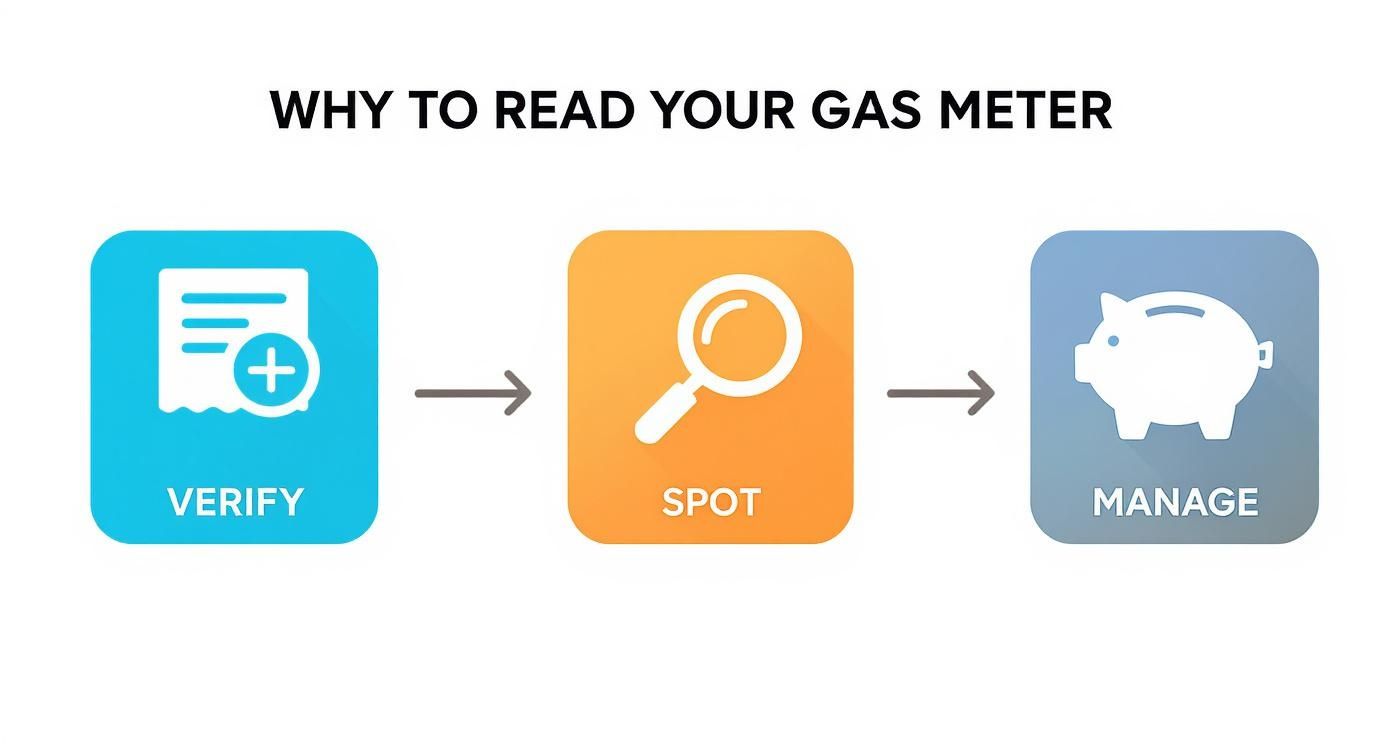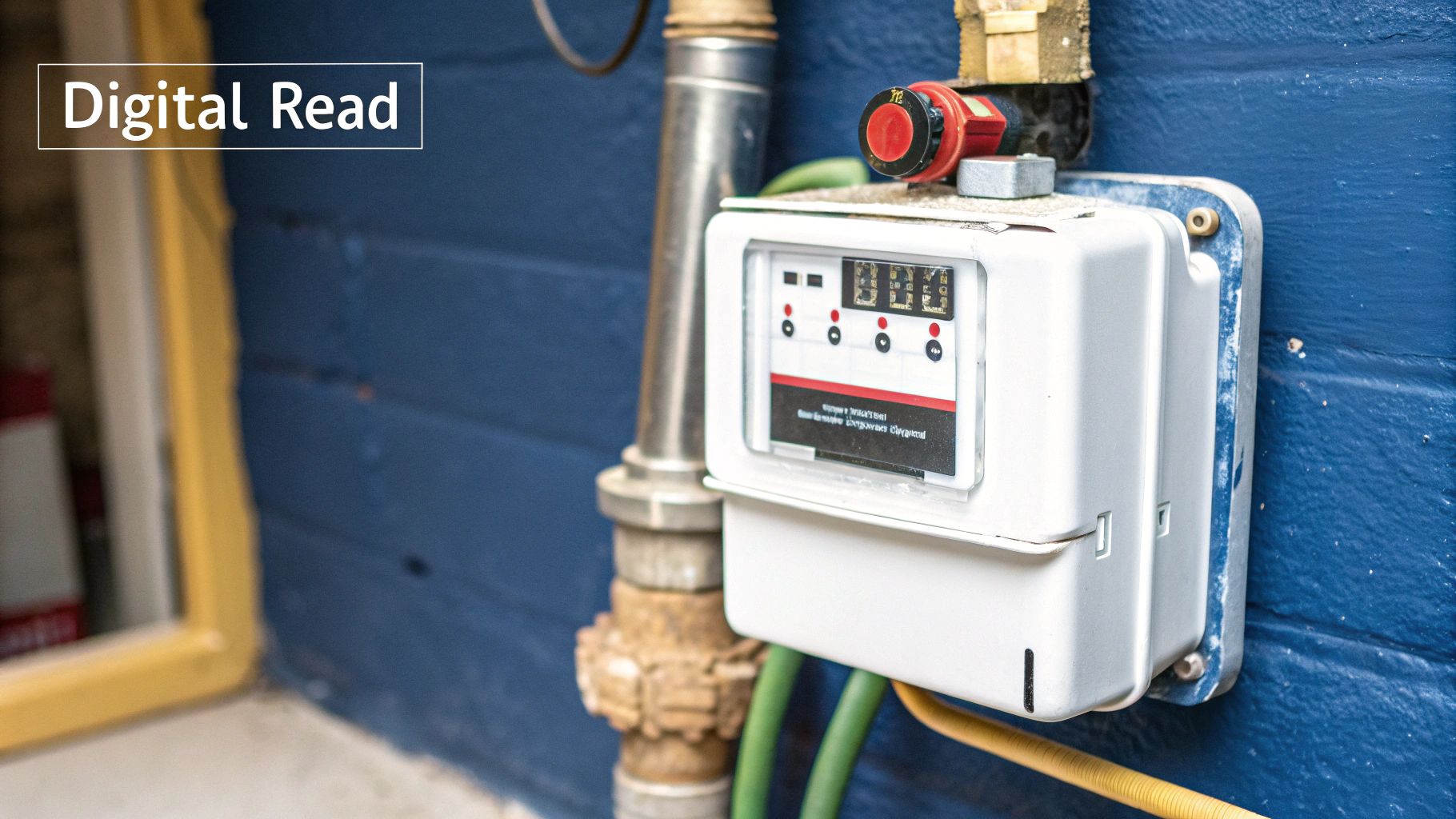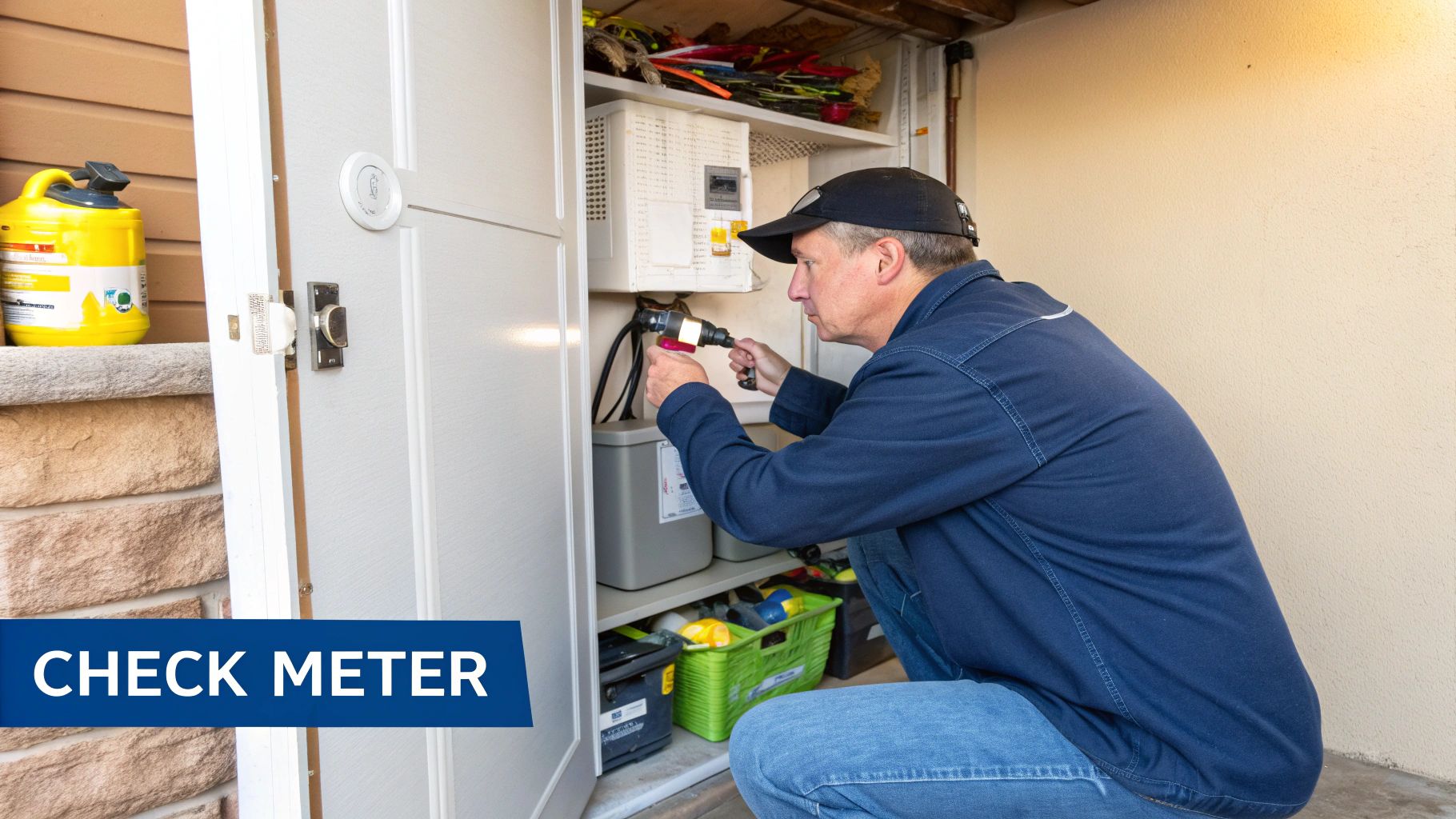How to Read Gas Meter: A Simple Guide for Australian Homes
Taking a moment to read your own gas meter is one of the fastest ways to get a real handle on your household energy costs. It’s a simple skill, but it puts you in the driver's seat. You can check your bills are accurate, spot any weird spikes in usage, and ultimately, get your budget under control.
Why You Should Read Your Own Gas Meter
Shifting from just paying the bill to actually understanding what you’re using is a game-changer for any homeowner. Knowing how to read your gas meter means you can make sure you’re only paying for the gas you’ve actually used. This is a big deal, because if your energy provider can’t get to your meter, they’ll often rely on an estimate, which can lead to a nasty surprise bill down the track.
Regularly checking your meter also works like an early warning system. A sudden, unexplained jump in your gas usage could be the first sign that an old appliance is on its last legs, long before it does serious damage to your wallet. In rare cases, it could even point to a potential gas leak, making it a valuable safety check.
"For millions of Australian homes, the path to accurate energy billing starts with a manual meter reading. Understanding this simple process is the first step toward gaining control over your household expenses and consumption patterns."
Across Victoria, New South Wales, and Queensland, gas usage data for around 3 million homes and small businesses is still collected from manually read meters. If you want to dig deeper, you can find out more about Australian gas meter data collection and its importance.
The Three Main Types of Gas Meters
Before we get into the how-to, you first need to figure out what kind of meter you’re working with. In Australia, you'll generally come across one of three types.
- Dial Meters: These are the old-school analogue ones that look a bit like a row of clocks. They can seem tricky, but once you know the rules, they’re straightforward.
- Digital Meters: A more modern setup with an LCD screen that just shows you the numbers. No guesswork involved.
- Smart Meters: These are the newest type. They send your usage data straight to your supplier automatically, but they also let you check your own consumption in near real-time.
Mastering the Dials on an Analogue Meter
Analogue gas meters, the ones with the little ‘clock faces’, can look a bit intimidating at first. But once you get the hang of them, you’ll find they’re surprisingly straightforward. The trick is to read them systematically, and you’ll be able to pull an accurate reading in just a few seconds.
You’ll see a row of four, five, or sometimes six small dials. Just like reading a book, you read these dials from left to right. Getting this sequence right is the first step to an accurate reading for your energy provider.
The Two Simple Rules for Reading Dials
Forget everything else and just remember two things. First, if a pointer is aimed squarely at a number, you just write down that number. Easy. The second rule is the one that really matters, and it’s for when a pointer is hovering between two numbers.
When a pointer is between two numbers, always, always record the lower of the two digits. This one tip prevents nearly all common meter reading mistakes.
So, if the pointer is sitting somewhere between the 4 and the 5, you write down 4. It doesn’t matter if it looks like it’s almost touching the 5 – the rule is to take the lower number.
You might also notice one quirky thing: the dials often turn in opposite directions. One will spin clockwise, and the one right next to it will go anti-clockwise. Don’t let this throw you off. It doesn't change a thing about how you read them; the "lower number rule" still applies no matter which way a dial is turning.
This infographic breaks down why taking a few minutes to get these readings can make a real difference to your household budget.

As you can see, it’s a simple loop: taking readings helps you verify your bills, spot potential issues early, and ultimately get a better handle on your energy spending.
Putting It All Together: A Practical Example
Let's walk through a real-world scenario to see how it works. Imagine your meter has four main dials. From left to right, you see the pointers are:
- First dial: Between 3 and 4. You record 3.
- Second dial: Between 7 and 8. You record 7.
- Third dial: Between 1 and 2. You record 1.
- Fourth dial: Between 5 and 6. You record 5.
String those numbers together and you get a final reading of 3715. Simple as that. You can safely ignore any extra dials, especially if they’re coloured red or labelled "1/10," as these are just for testing and not part of your billable reading.
This quick table can be a handy reference until you've got it down pat.
Quick Guide for Interpreting Dial Pointers
Use this reference to accurately determine the number to record based on where each pointer is positioned on the dial.
| Pointer Position | What to Record | Example |
|---|---|---|
| Directly on a number (e.g., 5) | The number it is pointing to | 5 |
| Between two numbers (e.g., between 7 and 8) | The lower of the two numbers | 7 |
| Between 9 and 0 | The lower number, which is 9 | 9 |
By keeping these straightforward rules in mind, you can confidently read any analogue meter.
There is one final exception to be aware of. If a pointer lands between the 9 and the 0, you should think of the 0 as a 10. This means 9 is the lower number. So, in that specific situation, you always record a 9. Once you've got that down, you’ve mastered it.
How to Read a Modern Digital Gas Meter

If you’ve ever squinted at the clock-like dials on an older gas meter, you’ll find the modern digital versions a welcome relief. Their simple design makes checking your gas usage quick and completely free of guesswork.
With a standard digital meter, what you see is what you get. The clear LCD screen shows a single row of numbers. Your job is to simply read them from left to right.
This string of digits is your total gas consumption, measured in cubic metres (m³). When you're jotting down the reading for your energy provider, just focus on the main numbers.
My tip is to ignore any numbers that show up after a decimal point. You can also disregard any digits that are in a different colour—usually red—as these are just for testing and won't affect your bill.
Sticking to the primary numbers ensures the reading you submit is spot on for billing.
Taking Control with a Smart Meter
Smart meters go one better by sending your usage data straight to your supplier automatically. That means no more estimated bills and no need for a technician to visit your property.
As Australia’s energy grid evolves, smart gas meters are becoming more common. They allow for remote readings, which cuts out manual checks and the human error that can come with them. You can learn more about the growth of smart gas meters in Australia and see how they're changing the game for energy management.
Even though it’s all automated, you can still check the reading yourself. A smart meter’s display will often cycle through different bits of information, but a quick press of a button should bring up your total consumption.
The real advantage, though, is found in your provider's online portal or app. This is where you can see a detailed breakdown of your gas usage, sometimes down to the day or even the hour. This empowers you to:
- Pinpoint high-usage times: See exactly when you’re burning through the most gas.
- Track your savings: Watch how changes in your habits impact your consumption.
- Set budget alerts: Get a heads-up if your usage is tracking higher than usual.
This level of insight gives you the power to take immediate action, making it easier than ever to get a handle on your energy costs.
Submitting a Reading and Understanding Your Bill
Once you’ve jotted down the numbers from your meter, the next step is getting them to your energy provider. Why bother? Because submitting your own reading is the surest way to dodge an inaccurate estimated bill.
Estimates happen when a meter reader can't physically access your property. It's your provider's best guess, but your own reading guarantees you only pay for the gas you’ve actually used. No more, no less.
Thankfully, most Aussie energy retailers have made this pretty painless. You can usually send your reading through:
- Their website: Just log into your online portal and look for a dedicated page to submit a reading.
- A mobile app: Many suppliers now have apps that make it as simple as snapping a photo or typing in the numbers.
- Over the phone: You can always call their customer service line and give them the details directly.
From Meter Numbers to Your Final Bill
Ever wondered how the digits on your meter dial translate into the dollar amount on your bill? It’s actually a straightforward conversion that turns your raw consumption into the units you're charged for.
Your meter tracks gas usage by volume, in cubic metres (m³). But your bill is calculated based on the energy content of that gas, which is measured in megajoules (MJ). To bridge the gap, your provider applies a "heating value" or "calorific value" to convert your cubic metres into megajoules.
Let’s say your reading shows you used 50 m³ of gas over a billing period. If the heating value for your area is 38.5 MJ/m³, the maths is simple:
50 m³ x 38.5 = 1925 MJ
Your bill would then be based on 1925 MJ of usage, multiplied by your provider's rate per megajoule. This calculation is what gives you full transparency over your energy charges.
Getting your head around this conversion is key to managing your energy budget. It directly connects the physical volume of gas you use with the final cost, empowering you to see how changes in your habits—like turning down the heater—really impact your expenses.
Knowing how your own usage fits into the bigger picture can also help you anticipate seasonal bill changes and budget more effectively. Consumer habits, especially increased heating in winter, have a direct influence on bills right across the country. You can even get a clearer picture of potential savings by plugging your numbers into a dedicated energy savings calculator to forecast your costs.
Troubleshooting Common Meter Reading Issues

Even with the best instructions, meters can sometimes throw you a curveball. Finding your meter box is locked is a common one, and it's tempting to try and force it. Don’t. A quick call to your gas provider is the right—and safest—way to get access.
A blank digital display is another frequent head-scratcher. It doesn’t automatically mean the meter is dead. Before you pick up the phone, try pressing any buttons on the meter's face. Often, that's all it takes to wake the screen up from a temporary fault.
When Your Reading Seems Wrong
An unusually high reading can definitely make your heart skip a beat. The first thing to do is simply double-check the numbers you wrote down. It's surprisingly easy to transpose a digit or misread a dial.
If the reading is correct but way out of line with your usual bills, it’s time to dig a little deeper.
"A meter reading that's wildly different from your typical usage should never be ignored. It's a clear signal to check your appliances for faults or, more critically, to perform a safety check for potential gas leaks."
What if the opposite happens? If your meter’s numbers haven’t moved at all in a few days, it could point to a stuck or faulty meter. The easiest way to check is to see if your gas appliances are working. Fire up the cooktop or run the hot water for a minute.
If gas is flowing but the meter is static, that’s a sure sign you need a professional to take a look. For sticky issues like that, it's always best to get a qualified technician involved. If you need help finding someone or have other urgent questions, you can always contact our expert team for guidance.
Still Have Questions About Your Gas Meter?
Even when you've got the basics of reading your meter down, a few common questions always seem to surface. Getting these sorted is the final step to feeling completely on top of your gas usage. Let’s run through the most frequent ones.
How Often Should I Read My Meter?
For the best results, get into the habit of taking a reading once a month. A great little trick is to time it with the day your billing cycle usually ends.
This simple routine is the single most effective way to check your bills against what your provider has on record. It also means you’ll spot any surprise spikes in usage straight away, not weeks later when the bill arrives.
What’s the Difference Between Imperial and Metric Meters?
Nearly all modern gas meters in Australia are metric, which means they measure your gas consumption in cubic metres (m³).
You might, however, still find an older imperial meter at your property, which measures in cubic feet (ft³). Your energy bill will always make it clear which unit your provider is using, but it's safe to assume any new meter is metric.
My Gas Bill Was an Estimate. What Do I Do?
If an estimated bill lands in your inbox, the best thing to do is take an actual meter reading yourself as soon as you can. Jump onto your energy supplier's website or give them a call to submit your numbers.
They’ll then recalculate your account so you only pay for the gas you’ve actually used. Of course, taking your own regular readings is the best way to stop this from happening in the first place.
An estimated bill is just your provider's best guess. Submitting your own reading replaces that guess with a hard fact, putting you back in control of your energy costs and preventing surprise bills later on.
For a deeper dive into other common queries, our complete guide has you covered. Feel free to explore a whole range of topics over in our comprehensive help and FAQs section.


